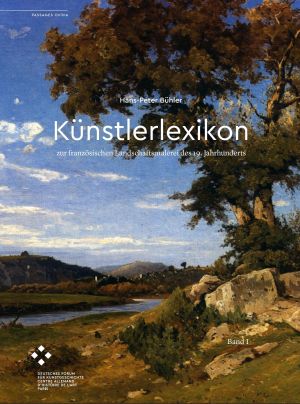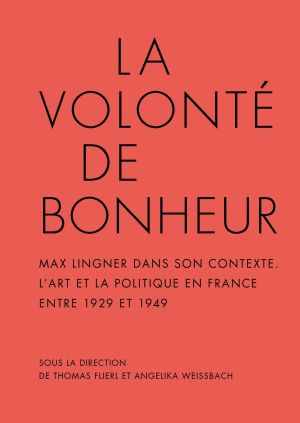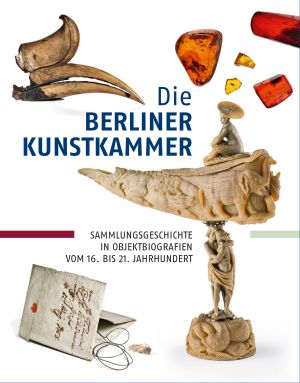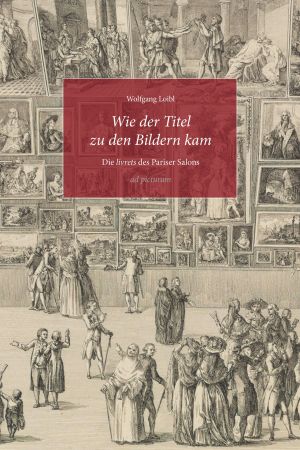Books
Das EU-Format „Kulturhauptstadt Europas“ zwischen lokalen und internationalen Kulturpolitiken: Einsichten aus dem deutschen Auswahlverfahren für die Kulturhauptstadt 2025
The ‘European Capital of Culture’ is regarded as the European Union's flagship cultural policy initiative. A total of eight German cities applied in a selection process for this title for 2025, which was ultimately awarded to Chemnitz. Cultural and cultural policy events and, for example, public discussions in the cities preceded the submission of the bid books. The article provides an insight into the selection process, the city's application activities and the local urban, cultural and European policy debates. It shows how different interpretations of the EU format intertwine and favour its success.
Vom Fließen der Dinge: Konzepte, Motive und Paradigmen von Fluidität aus frühneuzeitlichen und gegenwärtigen Perspektiven
The idea that the beginnings of the universe do not lie in the solid, hard, rigid, but also not simply in the opposite, the flowing and streaming, has occupied natural philosophical reflections for thousands of years. To this day, however, a binary-structured view of the world has unfolded in all its power. Impulses can already be identified in the early modern history of ideas and images that undermine the supposedly static, immobile and instead emphasise the changeable, ephemeral and dynamic. Stasis is dynamised and subjected to transformation in many different ways and in just as many different areas. The contributions in this volume present case studies from philosophical, physical, geoscientific, climatological and art scientific perspectives that bring the phenomenon within an interdisciplinary spectrum
Il cardinale Federico Borromeo e il pittore Jan Brueghel dei Velluti: Lettere e documenti inediti
This study presents various unpublished letters whose senders or recipients were the cardinal and archbishop of Milan Federico Borromeo, his nephew Count Giovanni Borromeo, the painter Jan Brueghel (Velvet Brueghel) and his son Jan Brueghel the Younger. Some of these missives allow us, also through a comparison with other documents already known, to almost hear the voice of the cardinal himself talking to his favourite Flemish painter, whom he admired so much. Furthermore, published here for the first time are various payments in favour of Jan Brueghel ordered by Cardinal Borromeo and recorded in the account ledgers of the archiepiscopal Curia of Milan. This work discloses also other letters and several unpublished archive papers which allow us to have more precise information not only on some paintings located in the Pinacoteca Ambrosiana, but also on other institutions of the Ambrosiana itself, such as the Biblioteca, the Collegio dei Dottori and the Accademia del Disegno. A chapter of this study is also dedicated to the problematic relationship between Cardinal Borromeo and Caravaggio with the analysis of some significant, little-known testimonies relating to the Lombard painter.
Art médiéval et médiévalisme
The ‘Middle Ages’ is a recent and shifting creation, at once a stratified historiographical elaboration and an appreciation of historical objects in the present. What we know and imagine shapes our perception. Studying the medieval arts therefore requires us to study medievalisms, and vice versa.
This volume, the result of work carried out in 2015/2016 at the German Centre for Art History in Paris, brings together fifteen studies on medieval artefacts and their subsequent history, up to the present day. They are accompanied by a review of German-language studies of medieval art in France since 1933.
VER – WANDLUNG – EN: Tagungsband anlässlich des 100. Kunsthistorischen Studierendenkongresses in München
The exploration of changes and transformations in art and art history is a rich and multifaceted endeavor. Following the 100. Kunsthistorischer Studierendenkongress (100th Art History Students’ Conference) themed “VerWandlungEn” (Transformations) this edited volume documents academic research focused on these dynamic processes. It highlights metamorphoses across various artistic subjects, media, structures, and institutions, addressing the inherent changeability and development within the field. In addition to outlining specific topics, fundamental questions about the student conference itself will also be addressed.
Bauten – Bilder – Geschichten. Kunsthistorische Perspektiven auf Architektur: Festschrift für Christian Freigang
What defines an art historical approach to architecture? What intellectual pursuits does it engage in, and what knowledge can it ultimately produce? This Festschrift, honouring Christian Freigang on his 65th birthday, assembles fifteen contributions from his esteemed colleagues. The essays explore various buildings, images, and narratives spanning from the Middle Ages to the present, providing insights into these fundamental questions. Reflecting the diverse range of Freigang's research interests, the contributions have been thoughtfully curated by the editors to foster a scholarly dialogue.
L’ expérience sensorielle dans les expositions d’art au XVIIIe siècle: The Sensory Experience in 18th Century Art Exhibitions
In the 18th century, the art exhibitions organized at the Louvre in Paris by the Royal Academy of Painting and Sculpture created an unprecedented socio-cultural event, which quickly aroused curiosity and envy in the French provinces and other nations. A visit to the Salon du Louvre or any other art exhibition, where the desire to be entertained and educated, was an experience that appeals to all the senses. This makes it obvious to introduce the notion of the ‘sensory body’, since not only sight but also hearing, touch, smell and taste are called upon in a variety of and in complex ways at every moment of the visit. Through different approaches, this book aims to transcribe the experiences of visitors to art exhibitions during the long eighteenth century (1680-1815) in Europe, based on visual and textual sources, and understood in the broadest sense of the term.
Au XVIIIe siècle, les expositions d’art organisées au Louvre à Paris par l’Académie royale de Peinture et de Sculpture créent un événement socioculturel inédit, qui a rapidement suscité la curiosité et l’envie du public de province et des autres nations. La visite du Salon du Louvre ou de toute autre exposition d’art, où s’entremêlent la volonté de se divertir et celle de s’instruire, se présente alors comme une expérience où les différents sens sont sollicités. Il est alors possible d’introduire la notion de « corps sensoriel », car non seulement la vue, mais encore l’ouïe, le toucher, l’odorat et le goût sont interpelés de manière variée et complexe à tout moment de la visite. À travers différentes approches, ce livre vise à retranscrire les expériences des visiteurs des expositions d’art entendues dans leur acception la plus large durant le long XVIIIe siècle (1680-1815) en Europe en s’appuyant sur les sources visuelles et textuelles de l’époque.
Künstlerlexikon zur französischen Landschaftsmalerei des 19. Jahrhunderts
The present encyclopaedia of French landscape painting is the result of decades of research, gathering, and documenting, to which the archaeologist, art collector, and gallerist Hans-Peter Bühler has dedicated himself. It registers more than three thousand entries on artists of landscape, marine, and architectural painting who were born between 1800 and 1870. Defining key works and providing biographical and bibliographical information, the two-volume work enables numerous cross-references among schools and currents of nineteenth-century French landscape painting – an area of artistic production whose striking diversity runs contrary to our frequent notion of art history as reducible to a select few names.
Wiener Moderne International: Export & Experiment in der Architektur der Jahrhundertwende
Architecture and art from around 1900 have dominated the perception of Vienna for the past five decades. The modernist experiment is still clearly inscribed in the cityscape today, in contrast to the migration and mobility of the architects, which often remain obscured. Wiener Moderne International sheds light on the complex exchange of knowledge and actors who shaped Viennese turn-of-the-century architecture and exported it throughout the Austro-Hungarian Empire and beyond.
Der Wille zum Glück. Max Lingner im Kontext: Kunst und Politik in Frankreich 1929–1949
This anthology links the work of the Max Lingner Foundation in Berlin with current research on the history of art, politics and culture in France in the interwar period. In addition to the classic biographical perspective on Max Lingner's life story, the texts by scientists from both countries focus on the broader artistic and political context. The leitmotif for this volume, "The Will to Happiness", stands for the upheaval of the Front Populaire in 1936 and also places the painter and press illustrator Max Lingner in this context.
Hello Nature: Wie wollen wir zusammenleben?
The book accompanying the exhibition ‘Hello Nature. How best to live with you?’ explores mankind's enduring engagement with nature, shaped by the conflicting dynamics of subjugation, dangers and conservation. In what ways have humans shaped nature? What limits does nature set for humans? And: How can we create a new form of coexistence? Tracing an arc from prehistory and early history to the present reveals the extent to which culture has informed our perception of and interaction. In order to master the current ecological crises, a cultural change is also necessary. We need new visions, images and narratives in order to develop a sustainable coexistence between humans and nature.
Die Beinsättel des 13. bis 17. Jahrhunderts: Reitzeuge als Sinnbilder ritterlich-höfischer Ideale
Saddles and saddle fragments from the 13th to 17th centuries are kept in museums all over the world and fascinate with their magnificent surface-covering bone work. They seem unsuitable as riding seats due to their detailed decoration, but for which purpose were they made? Based on comprehensive object studies and contemporary textual and visual sources, Maria Schröder determines the original meaning and function of the bone saddles. The roman courtois in particular is a key source here. The bone saddles prove to be a medium of representation for the aristocratic and later also the bourgeois elite. The study is of outstanding interest for ivory research, early material culture and material semantics.
Bildpolemischer Künstlerstreit: Von Leonbruno bis Hogarth
Based on 18 cases dated between 1525 and 1763, this monograph, an output of the DFG project "Visual Artists’ Disputes and their Strategies in the Early Modern Era", explains how we can recognize that paintings, reliefs or prints were created in connection with a disagreement between artists or with their patrons. Works by, among others, Leonbruno, Lelio Orsi, Stradanus, Federico Zuccari, Leone Leoni, Rembrandt, Piranesi and William Hogarth show the creative handling of censorship and with moral bans of offensive depictions of people. The comparative overview exposes traditions of visual polemic codes: Artistic competition without emotion is a fiction of powerful legends.
La volonté de bonheur: Max Lingner dans son contexte. L’art et la politique en France entre 1929 et 1949
This anthology links the work of the Max Lingner Foundation in Berlin with current research on the history of art, politics and culture in France in the interwar period. In addition to the classic biographical perspective on Max Lingner's life story, the texts by scientists from both countries focus on the broader artistic and political context. The leitmotif for this volume, "The Will to Happiness”, stands for the upheaval of the Front Populaire in 1936 and also places the painter and press illustrator Max Lingner in this context.
German Version: Der Wille zum Glück. Max Lingner im Kontext
The Berlin Kunstkammer: Collection History in Object Biographies from the 16th to the 21th Century
The Berlin Kunstkammer as such never existed. In the course of its long history, the electoral and then royal institution underwent continuous change. In dealing with the collection, the protagonists constantly reinvented the Brandenburg-Prussian Kunstkammer. This book takes an innovative approach to the multiple meanings of the history of the collection by examining the biographies of its objects. Like prisms, these holdings refract the history of the Kunstkammer from its beginnings around 1600 to the present day, showing the kaleidoscopic meanings attributed to artefacts and natural objects. The texts, written by authors from a variety of disciplines, trace the early history of Berlin’s modern museum landscape and the differing paths that brought objects into the collections. The contributions present the results of a joint research project by the Humboldt-Universität zu Berlin, the Museum für Naturkunde Berlin, and the Staatliche Museen zu Berlin.
The book has also been published in German: https://doi.org/10.11588/arthistoricum.1461
Erschütterung. Erde und Erbe in der Krise: Tremor. Earth and Heritage in Crisis
Erschütterung (tremor) discusses the destruction and damage to architectural monuments caused by physical crises such as earthquakes, floods or war, as well as the emotional, social and societal shocks that arise in this context. The subtitle Earth and Heritage in Crisis refers to the close links between global disasters, heritage making and preservation. The conference volume therefore deals with fundamental questions about how heritage preservation deals with such crises and their consequences. In addition to topics of conservation and restoration, strategies of reconstruction and remembrance, it is asked how the discipline of heritage preservation itself has been shaped by crises. Interdisciplinary case studies will be used to discuss the limits, possibilities and conflicts of heritage preservation caused by war and trauma.
Die Berliner Kunstkammer: Sammlungsgeschichte in Objektbiografien vom 16. bis 21. Jahrhundert
The Berlin Kunstkammer as such never existed. In the course of its long history, the electoral and then royal institution underwent continuous change. In dealing with the collection, the protagonists constantly reinvented the Brandenburg-Prussian Kunstkammer. This book takes an innovative approach to the multiple meanings of the history of the collection by examining the biographies of its objects. Like prisms, these holdings refract the history of the Kunstkammer from its beginnings around 1600 to the present day, showing the kaleidoscopic meanings attributed to artefacts and natural objects. The texts, written by authors from a variety of disciplines, trace the early history of Berlin’s modern museum landscape and the differing paths that brought objects into the collections. The contributions present the results of a joint research project by the Humboldt-Universität zu Berlin, the Museum für Naturkunde Berlin, and the Staatliche Museen zu Berlin.
The book has also been published in English: https://doi.org/10.11588/arthistoricum.1383
Das Vermächtnis des Steins: Morphologische Dramaturgien zwischen Transition und Transformation im Werk Andrea Mantegnas
Andrea Mantegna's paintings are distinguished by the intricate interplay of various elements, particularly the dynamic relationship between organic and inorganic carriers of significance. Of notable significance are the mineral-like textures and objects, serving as transitional mediums that blur the distinction between animate and inanimate entities, between stillness and vitality. This study delves into these compelling aspects of material representation and aesthetics, focusing on the potential reception and exchange processes within the intellectual milieu of Quattrocento natural philosophy.
Photographic Thought Pieces: Kenneth C. & Sabina R. Korfmann-Bodenmann: “Through Different Lenses”, Sixteen Portfolios, 2019–2022
Under the artistic concept “Through Different Lenses”, Sabina R. and Kenneth C. Korfmann-Bodenmann address contemporary and culturally relevant topics in discrete photo projects. These include fortifications from the Second World War, unusual presentations of fashion and religion, diverse architectural interpretations of social hotspots, experiences of loneliness and the mythology of places and landscapes. For each theme, the photographers plan expeditions that are focused on discovery and documentation. The difference between the perspectives of the two photographers is preserved despite their forays together. The publication presents and analyzes sixteen portfolios with a total of 384 photographs.
feld & wege: 100 Jahre Forschung und Dokumentation – von der Volkskunde zur Alltagskultur
This anniversary volume celebrating the 100th anniversary of the Landesstelle für Alltagskultur is inspired by the theme of "Wandering". This is a reference to the beginnings of the subject of folklore and the founding of the regional office in 1923. Early researchers undertook hikes at the end of the 19th century and published their observations and experiences with "the land and the people". Today, too, it is about being on the move in the field and in the region, on old and new paths, in known and unknown places, which leads to different perspectives, views and outlooks, which the authors of this volume share with us. They not only provide insights into their academic work, but also share their experiences and expectations with regard to the Landesstelle für Alltagskultur in the past, present and future.
L’urbain et le sensible: Expériences artistiques
This book is the result of a fruitful exchange between scholarship holders and guests of the DFK Paris as part of the 2021-2022 annual theme ‘Street Art’. The authors gathered here with their contributions share an interest in aesthetic practices in urban space and its use. Their aim is to raise awareness of the ways in which the city can be appropriated through a gaze, a path or through writing, be it in a political, visual artistic, democratic, challenging, playful or multi-sensory form. One of the peculiarities of this relationship is the shared, pronounced sense of questions of emotionalisation and taste judgement. As a fundamental factor, the street lends its aesthetic dimension to such behaviour.
Cet ouvrage rassemble la somme des fructueux échanges menés par les boursiers et les invités du DFK Paris dans le cadre du sujet annuel 2021-2022 « Street Art ». Tous partagent un intérêt pour les pratiques et les usages sensibles de l’espace urbain – autrement dit, les manières de s’emparer de la ville par un regard, un parcours, des écrits, que ce soit par une forme politique, esthétique, démocratique, revendicative, ludique ou multisensorielle. L’une des particularités de ces pratiques est un sens aigu des émotions et des goûts partagés avec d’autres. Composante fondamentale, la rue leur confère une dimension esthétique.
Colonial Dimensions of the Global Wildlife Trade
This volume resulted from an international conference that took place in November 2022 at the Georg-August-Universität Göttingen. The aim was to examine the colonial dimensions of the global wildlife trade in the first half of the 20th century, and its connections to other forms of trade, e.g., with human remains, animal material or ethnographic objects. In particular, the papers scrutinise the legacy of this trade - in the regions of origin, but also in European and North American institutions.
The conference and the volume are linked to the project "The global networks of the animal trading companies Reiche and Ruhe - provenance research on the circulation of animals, humans and objects in the 19th and 20th centuries”, which is based at the Chair of Modern History at the University of Göttingen and is funded by the German Lost Art Foundation. It is conducted in cooperation with the Municipal Museum of Alfeld and the Network for Provenance Research in Lower Saxony.
Mandragora – Pflanzen als Künstler: Eine Naturgeschichte des Bilder-Machens in der Frühen Neuzeit
Plants produce images, nature is an artist. What reads like an avowal of contemporary eco-art was already a subject of intense interest in early modern times: after all, there are many forms in nature that are reminiscent of a human figure - such as the mandragora or mandrake root. Explanations ranged from superstition and speculation about divine messages hidden in creation to scientific theories. At the same time, the relationship between natural and artificial products and the conditions for precise observation were also considered. One highlight of these discussions was the publication of an anthropomorphic beetroot in 1670 in Germany's first scientific journal.
Réseaux et académies d'art au Siècle des lumières en province
Ce livre est le fruit des six années de recherche du programme ACA-RES sur Les académies d’art et leurs réseaux dans la France préindustrielle. Il explore le rôle des provinces dans l’élaboration d’une pratique moderne de l’art, entre apprentissage des règles du goût et réponse aux réalités sociales et culturelles des territoires. Il fait sortir de l’ombre artistes, amateurs, dessinateurs des manufactures, entrepreneurs, marchands, notables des villes qui, loin d’être tournés vers des cercles fermés, apparaissent en relation permanente avec le monde. Ainsi est-ce donc une histoire inédite des circulations des modèles artistiques qui se dessine ici, comme des multiples acteurs de l’art agissant pour sa révolution.
Wie der Titel zu den Bildern kam: Die livrets des Pariser Salons
For a long time, works of art with traditional pictorial motifs were sufficiently comprehensible even without titles. Why, when and under what circumstances were titles nevertheless created? The livrets - the exhibition cata logues of the Paris Acaddmie roya le de peinture et de sculpture - provide an answer to this question. Due to their long, continuous series of publications, the catalogues of the respective exhibition objects form an excellent source for the diachronic examination of the creation of titles.
The genesis of the titles shows a gradual transition from descriptions of the works to concise short titles: The emergence of new, previously unknown pictorial motifs, the development of the art market and the beginning of art criticism demanded and favoured short, easy-to-read titles that facilitated rapid identification of the content of the work as well as art-theoretical discourse on the artist and the work.































